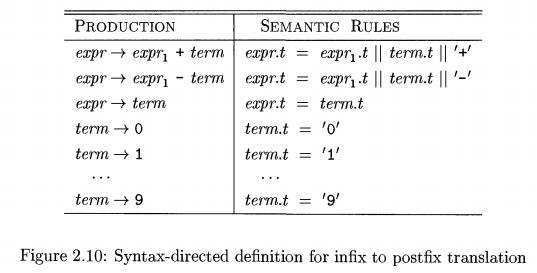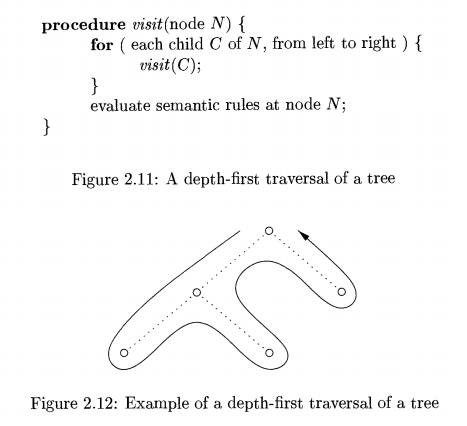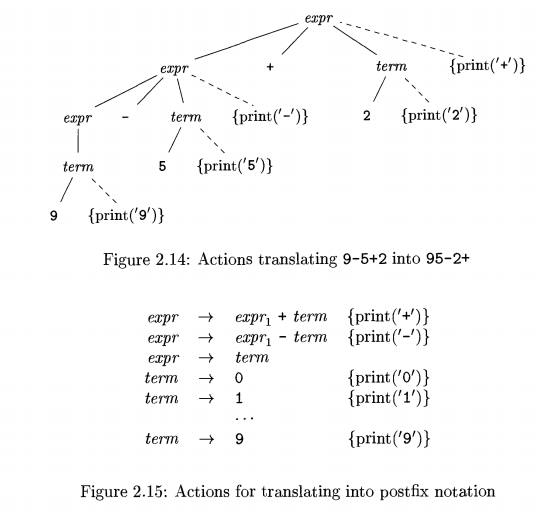Chapter: Compilers : Principles, Techniques, & Tools : A Simple Syntax-Directed Translator
Syntax-Directed Translation
Syntax-Directed Translation
1 Postfix Notation
2 Synthesized Attributes
3 Simple Syntax-Directed
Definitions
4 Tree Traversals
5 Translation Schemes
6 Exercises for Section 2.3
Syntax-directed translation is done by attaching rules or program
fragments to productions in a grammar. For example, consider an expression expr generated by the production
expr -» exprx + term
Here, expr is the sum of the two
subexpressions exprx and term. (The subscript in exprx is used
only to distinguish the instance of expr in the production body from the head of the
production). We can translate
expr by exploiting its structure,
as in the following pseudo-code:
translate exprx;
translate term;
handle +;
Using a variant of this pseudocode, we shall build a syntax tree for expr in Section 2.8 by building syntax
trees for exprt and term and then handling +
by constructing a node for it. For convenience, the example in this section is
the translation of infix expressions into postfix notation.
This section introduces two concepts related to syntax-directed
translation:
• Attributes. An attribute is any quantity
associated with a programming construct.
Examples of attributes are data types of expressions, the num-ber of
instructions in the generated code, or the location of the first in-struction
in the generated code for a construct, among many other pos-sibilities. Since
we use grammar symbols (nonterminals and terminals) to represent programming
constructs, we extend the notion of attributes from constructs to the symbols
that represent them.
• (Syntax-directed) translation schemes. A
translation scheme is a notation for
attaching program fragments to the productions of a grammar. The program
fragments are executed when the production is used during syn- tax analysis. The combined result of all these fragment
executions, in the order induced by the
syntax analysis, produces the translation of the program to which this
analysis/synthesis process is applied.
Syntax-directed translations will be used throughout this chapter to
trans-late infix expressions into postfix notation, to evaluate expressions,
and to build syntax trees for programming constructs. A more detailed
discussion of syntax-directed formalisms appears in Chapter 5.
1. Postfix Notation
The examples in this section deal with translation into postfix
notation. The postfix notation for an
expression E can be defined inductively
as follows:
1. If E is a variable or
constant, then the postfix notation for E
is E itself.
2. If E is an expression of
the form E1 op E2, where op is any binary operator, then the postfix notation for E is E[ E'2 op, where E[ and E'2 are the
postfix notations for E1 and E2, respectively.
3. If E is a parenthesized expression of the
form (Ei), then the postfix notation
for E is the same as the postfix
notation for E1.
E x a m p l e 2.8 : The postfix notation for (9 -
5)+2 is 95-2+. That is, the trans-lations
of 9, 5, and 2 are the constants themselves, by rule (1). Then, the translation of 9-5
is 95 - by rule (2). The translation of (9 -
5) is the same by rule (3).
Having translated the parenthesized subexpression, we may apply rule (2) to the
entire expression, with (9 - 5) in the
role of E1 and 2 in the role of E2: to get the result 95-2+.
As another example, the postfix notation for 9- (5+2) is 952+-. That
is, 5+2 is first translated into 52+, and this expression becomes the
second argument of the minus sign. •
No parentheses are needed in postfix notation, because the position and arity (number of arguments) of the
operators permits only one decoding of a postfix
expression. The "trick" is to repeatedly scan the postfix string from
the left, until you find an operator. Then, look to the left for the proper
number of operands, and group this operator with its operands. Evaluate the
operator on the operands, and replace them by the result. Then repeat the
process, continuing to the right and searching for another operator.
E x a m p l e 2 . 9 : Consider the postfix expression
952+-3*. Scanning from the left,
we first encounter the plus sign. Looking to its left we find operands 5 and 2. Their sum, 7, replaces 52+, and we have the string 97 - 3* . Now, the leftmost operator
is the minus sign, and its operands are 9
and 7. Replacing these by the result
of the subtraction leaves 23*. Last,
the multiplication sign applies to 2 and 3, giving the result 6. •
2. Synthesized Attributes
The idea of associating quantities with programming constructs—for
example, values and types with expressions—can be expressed in terms of
grammars. We associate attributes with nonterminals and terminals. Then, we
attach rules to the productions of the grammar; these rules describe how the
attributes are computed at those nodes of the parse tree where the production
in question is used to relate a node to its children.
A syntax-directed definition associates
1. With each grammar symbol, a
set of attributes, and
2. With each production, a set of semantic
rules for computing the values of the attributes associated with the
symbols appearing in the production.
Attributes can be evaluated as follows. For a given input string x, construct a parse tree for x. Then, apply the semantic rules to
evaluate attributes at each node in the parse tree, as follows.
Suppose a node A?" in a parse tree is labeled by the grammar symbol
X. We write X.a to denote the value of attribute a of X at that node. A
parse tree showing the attribute values at each node is called an annotated parse tree. For example, Fig. 2.9 shows an annotated parse tree for 9-5+2 with an attribute t associated with the nonterminals expr and term. The value 95-2+ of the attribute at the
root is the postfix notation for 9-5+2.
We shall see shortly how these
expressions are computed.

An attribute is said to be synthesized
if its value at a parse-tree node N
is de-termined from attribute values at the children of N and at N itself.
Synthesized attributes have the desirable property that they can be evaluated
during a sin-gle bottom-up traversal of a parse tree. In Section 5.1.1 we shall
discuss another important kind of attribute: the "inherited"
attribute. Informally, inherited at-tributes have their value at a parse-tree
node determined from attribute values at the node itself, its parent, and its
siblings in the parse tree.
Example 2 . 1 0 : The annotated parse tree in Fig. 2 . 9 is based on the syntax-directed
definition in Fig. 2 . 1 0 for translating expressions consisting of digits
separated by plus or minus signs into postfix notation. Each nonterminal has a
string-valued attribute t that
represents the postfix notation for the expression generated by that
nonterminal in a parse tree. The symbol || in the semantic rule is the operator
for string concatenation.

The postfix form of a digit is the digit itself; e.g., the semantic rule
associ-ated with the production term -» 9 defines term.t to be 9 itself
whenever this production is used at a node in a parse tree. The other digits
are translated similarly. As another
example, when the production expr term is applied, the value of term.t becomes the value of
expr.t.
The production expr —> exprx + term derives an expression containing
a plus operator.3 The left operand of the plus operator is given by exprx and the
right operand by term. The semantic
rule
expr.t = expr.t
\\ term.t \\ '+'
associated with this production constructs the value of attribute expr.t by con-catenating the postfix
forms expr.t and term.t of the left and right operands, respectively, and then
appending the plus sign. This rule is a formalization of the definition of
"postfix expression." •
Convention Distinguishing Uses of
a Nonterminal
In rules, we often have a need to distinguish among several uses of the
same nonterminal in the head and/or body of a production; e.g., see Ex-ample
2.10. The reason is that in the parse tree, different nodes labeled by the same
nonterminal usually have different values for their transla-tions. We shall
adopt the following convention: the nonterminal appears unsubscripted in the
head and with distinct subscripts in the body. These are all occurrences of the
same nonterminal, and the subscript is not part of its name. However, the
reader should be alert to the difference be-tween examples of specific
translations, where this convention is used, and generic productions like A —> X1X2, • • • ,Xn, where
the subscripted X ' s represent an arbitrary list of grammar symbols, and are not instances of one particular
nonterminal called X.
3. Simple Syntax-Directed
Definitions
The syntax-directed definition in Example 2.10 has the following
important property: the string representing the translation of the nonterminal
at the head of each production is the concatenation of the translations of the
nonterminals in the production body, in the same order as in the production,
with some optional additional strings interleaved. A syntax-directed definition
with this property is termed simple.
E x a m p l e 2 . 1 1 : Consider the first production
and semantic rule from Fig. 2.10:
P R O D U C T I O N S E M A N T I C R U L E
(2.5)
expr^r exprx + term expr.t = exprx.t || term.t
|| '+'
Here the translation expr.t is
the concatenation of the translations of exprx and term, followed by the
symbol +. Notice that expr1 and term appear in the same order in both the production body and the semantic rule.
There are no additional symbols before or between their translations. In this
example, the only extra symbol occurs at the end. •
When translation schemes are discussed, we shall see that a simple
syntax-directed definition can be implemented by printing only the additional
strings, in the order they appear in the definition.
4. Tree Traversals
Tree traversals will be used for describing attribute evaluation and for
specifying the execution of code fragments in a translation scheme. A traversal of a tree starts at the root
and visits each node of the tree in some order.
A depth-first traversal starts at
the root and recursively visits the children of each node in any order,
not necessarily from left to right. It
is called "depth-first" because it visits an unvisited child of a
node whenever it can, so it visits nodes as far away from the root (as
"deep") as quickly as it can.
The procedure visit(N) in Fig.
2.11 is a depth first traversal that visits the children of a node in
left-to-right order, as shown in Fig. 2.12. In this traversal, we have included
the action of evaluating translations at each node, just before we finish with
the node (that is, after translations at the children have surely been
computed). In general, the actions associated with a traversal can be
whatever we choose, or nothing at all.

A syntax-directed definition does not impose any specific order for the
eval-uation of attributes on a parse tree; any evaluation order that computes
an attribute a after all the other attributes that a depends on is acceptable. Syn-thesized attributes can be evaluated
during any bottom-up traversal, that
is, a traversal that evaluates attributes at a node after having evaluated
attributes at its children. In general, with both synthesized and inherited
attributes, the matter of evaluation order is quite complex; see Section 5.2.
5. Translation Schemes
The syntax-directed definition in Fig. 2.10 builds up a translation by
attaching strings as attributes to the nodes in the parse tree. We now consider
an alter-native approach that does not need to manipulate strings; it produces
the same translation incrementally, by executing program fragments.
Preorder and Postorder Traversals
Preorder and postorder traversals are two important special cases of
depth-first traversals in which we visit the children of each node from left to
right.
Often, we traverse a tree to
perform some particular action at each node. If
the action is done when we first visit a node, then we may refer to the
traversal as a preorder traversal.
Similarly, if the action
is done just before we leave a
node for the last time, then we say it is a postorder traversal of the tree.
The procedure visit(N) in Fig. 2.11 is an example of a postorder traversal.
Preorder and postorder traversals define corresponding orderings on
nodes, based on when the action at a node would be performed. The preorder of a (sub)tree rooted at node
JV consists of N, followed by the preorders of the subtrees of each of
its children, if any, from the left. The postorder
of a (sub)tree rooted at TV" consists of the postorders of each of the subtrees for the children of N, if any, from the left, followed by N itself.
A syntax-directed translation scheme is a notation for specifying a
transla-tion by attaching program fragments to productions in a grammar. A
transla-tion scheme is like a syntax-directed definition, except that the order
of evalu-ation of the semantic rules is explicitly specified.
Program fragments embedded within production bodies are called semantic actions. The position at which an action is to be executed is shown
by enclosing it between curly braces
and writing it within the production body, as in
rest —> + term {print('+')} rest\
We shall see such rules when we consider an alternative form of grammar
for expressions, where the nonterminal rest
represents "everything but the first term of an expression." This
form of grammar is discussed in Section 2.4.5. Again, the subscript in rest\ distinguishes this instance of
nonterminal rest in the production
body from the instance of rest at the
head of the production.
When drawing a parse tree for a translation scheme, we indicate an
action by constructing an extra child for it, connected by a dashed line to the
node that corresponds to the head of the production. For example, the portion
of the parse tree for the above production and action is shown in Fig. 2.13.
The node for a semantic action has no children, so the action is performed when
that node is first seen.
E x a m p l e 2 . 1 2 : The parse tree in Fig. 2.14 has print statements at extra leaves, which are attached by dashed
lines to interior nodes of the parse tree. The translation scheme appears in
Fig. 2.15. The underlying grammar gen-erates expressions consisting of digits
separated by plus and minus signs. The

actions embedded in the production bodies translate such expressions
into post-fix notation, provided we perform a left-to-right depth-first
traversal of the tree and execute each print statement when we visit its leaf.

The root of Fig. 2.14 represents the first production in Fig. 2.15. In a
postorder traversal, we first perform all the actions in the leftmost subtree
of the root, for the left operand, also labeled expr like the root. We then
visit the leaf + at which there is no action. We next perform the actions in
the subtree for the right operand term and, finally, the semantic action {
print('+') } at the extra node.
Since the productions for term have only a digit on the right side, that
digit is printed by the actions for the productions. No output is necessary for
the production expr -> term, and only the operator needs to be printed in
the action for each of the first two productions. When executed during a
postorder traversal of the parse tree, the actions in Fig. 2.14 print 95-2+. •
Note that although the schemes in Fig. 2.10 and Fig. 2.15 produce the
same translation, they construct it differently; Fig. 2.10 attaches strings as
attributes to the nodes in the parse tree, while the scheme in Fig. 2.15 prints
the translation incrementally, through semantic actions.
The semantic actions in the parse tree in Fig. 2.14 translate the infix
ex-pression 9-5+2 into 95-2+ by printing each character in 9-5+2 exactly once,
without using any storage for the translation of subexpressions. When the
out-put is created incrementally in this fashion, the order in which the
characters are printed is significant.
The implementation of a translation scheme must ensure that semantic
ac-tions are performed in the order they would appear during a postorder
traversal of a parse tree. The implementation need not actually construct a
parse tree (often it does not), as long as it ensures that the semantic actions
are per-formed as if we constructed a parse tree and then executed the actions
during a postorder traversal.
6. Exercises for Section 2.3
Exercise 2 . 3 . 1 : Construct a syntax-directed translation scheme that trans-lates
arithmetic expressions from infix notation into prefix notation in which an
operator appears before its operands; e.g., —xy
is the prefix notation for x — y.
Give annotated parse trees for the inputs 9-5+2 and 9-5*2.
Exercise 2 . 3 . 2: Construct a syntax-directed translation scheme that trans-lates
arithmetic expressions from postfix notation into infix notation. Give
annotated parse trees for the inputs 95 - 2* and 952* - .
Exercise 2 . 3 . 3: Construct a syntax-directed translation scheme that trans-lates integers
into roman numerals.
Exercise 2 . 3 . 4: Construct a syntax-directed translation scheme that trans-lates roman
numerals into integers.
Exercise 2 . 3 . 5: Construct a syntax-directed translation scheme that trans-lates postfix
arithmetic expressions into equivalent infix arithmetic expressions.
Related Topics